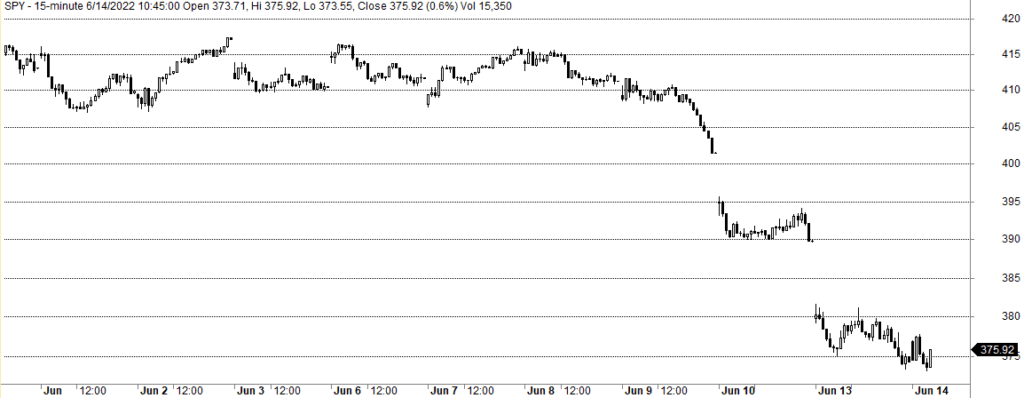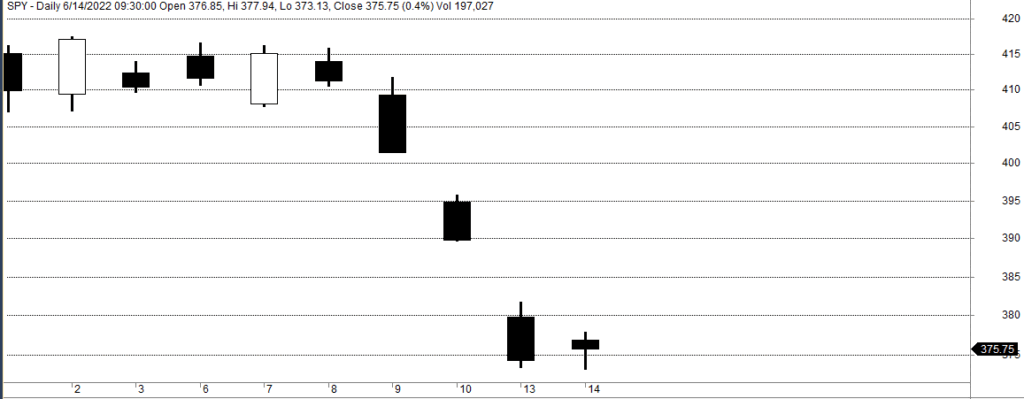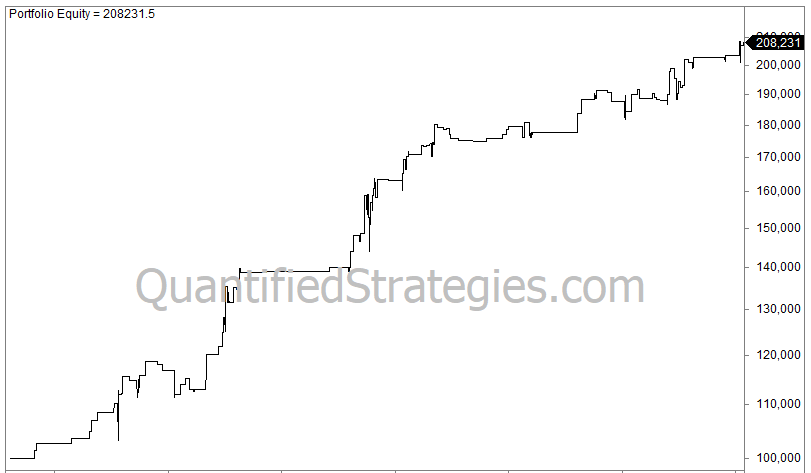Can You Day Trade With Daily Bars? Strategies and Backtesting
You might wonder which time frame to watch when day trading. Instinctively, you might believe you need intraday bars, i.e., 5-minute bars, 60-minute bars, etc. However, after reading this article, we hope you are reconsidering. Can you day trade with daily bars?
Yes, you can day trade with daily bars. As a matter of fact, this is a very viable option and for most traders a better solution than using intraday bars with a shorter time frame. We would even argue it’s better to use daily bars than intraday bars when day trading.
Key takeaways
- Contrary to the belief that day trading requires intraday charts (like 5-minute or 15-minute bars), the article argues that daily bars can be effectively used for day trading. This approach can simplify the trading process and reduce noise.
- Advantages of Using Daily Bars:
- Reduced Behavioral Mistakes: Less screen time can lead to fewer impulsive decisions.
- Less Market Noise: Daily bars filter out intraday volatility, making trends clearer.
- Time Efficiency: Traders can spend more time on research and less on monitoring charts.
- Compatibility with Day Jobs: This method allows individuals to trade without needing to watch the market all day.
- Disadvantages to Consider:
- Fewer Trading Opportunities: Using daily bars may result in fewer signals compared to intraday charts.
- Potential for Bad Quotes: daily high and low prices can sometimes be inaccurate due to after-hours activity or delayed trade reporting.
- Backtested Strategies:
- The article provides examples of short-selling strategies using daily bars on indices like the S&P 500 (SPY) and Nasdaq 100 (QQQ). These strategies are based on specific conditions and have been backtested for performance.
- Conclusion:
- While not traditional, day trading with daily bars is a legitimate approach that can offer several benefits, especially for those looking to minimize screen time and reduce emotional trading. However, it’s essential to be aware of its limitations and ensure strategies are thoroughly backtested.
What is a bar in trading?
Before we start, we’ll briefly explain what a bar is in trading.
A bar is the open, high, low, and close within a certain period. If you are using daily bars, the open is today’s opening print, the highest trade of the day, the lowest trade of the day, and the final closing price at the end of the official trading day.
You can, of course, adjust the length of the trading day yourself if you want to include “unofficial” trading outside regular exchange hours.
If you are using 5-minute bars, the open could be the opening price at 10 AM, the high between 1000 and 1005, the lowest trade between 1000 and 1005, and the close price at 1005.
A bar compresses data over a specific time frame.
The significance of daily bars
We believe that daily bars are the most significant time frame in trading. This applies equally to day traders and swing traders.
Why are we of that opinion?
In this post, we’ll argue the case for daily bars, even though you might be a day trader. There are also disadvantages, but they are more than offset by the advantages.
Day trading and different bars
Let’s start by showing the same time period in S&P 500 (SPY) by using two different time frames:
The first chart is 15-minute bars:

Let’s compress the same data into daily bars:
The difference is, of course, enormous. There is a lot less data!
Why could day trading with daily bars be better than intraday bars?
Let’s look at some of the possible benefits, pros, and advantages of using daily bars if you are a day trader:
Fewer behavioral mistakes
In our opinion, most of the price action is just randomness and noise. The more you stare at the screen(s), the more likely you are to do discretionary trades. In trading and investing, this is called behavioral mistakes. For example, one of the most common biases is the overconfidence bias that comes after a series of wins and gains.
Being systematic is one of the most important factors in becoming a profitable day trader. But the more noise you have, the more difficult it gets. Trading should be “simple”!
Less movement after the open and the close
We have looked at the intraday trading movement in multiple posts. In fact, the market slows down a lot after the first 30 minutes of the trading day. We believe that the best opportunities for day trading happen before the open, right after the open, and toward the close. We have day traded for 18 years, and we concentrated all our trading within these narrow time frames.
Less noise equals more time to research
We believe you are unlikely to succeed as a discretionary day trader and thus you need to constantly find new strategies by using backtesting. It’s much easier to backtest using daily bars than intraday bars. Furthermore, it’s also much more time-effective.
Less trading – more focus
Day trading involves profiting on small movements done repeatedly. Because much of the price action midday is random and slow, you need to focus your energy on the best opportunities. By using only the open and closed price for entry and exit, you have bigger profit potential.
Another bonus is less commissions and slippage. Slippage amounts increase with the more trades you make. For a sensible risk and reward, any daytrading strategy in liquid instruments should have at least 0.15% in expected gains per trade to cover commissions, slippage, and some profits.
Easier to day trade and having a job
We are day trading, but we buy and sell only at the open and the close. It saves us time, for example writing this post, and you can manage another job to have a regular income.
Disadvantages of using daily bars when day trading
Everything in life is a trade-off, also by using daily bars when day trading. We can only think of one major disadvantage of using daily bars when day trading:
Limited trading opportunities
If you mainly trade at the open and at the close, you limit yourself. There might be opportunities you are not aware of.
However, we have been backtesting extensively for 20 years, and we believe there are, in general terms, very few opportunities worth chasing outside the open and the close (this applies to all markets).
Bad quotes
One other aspect of using daily bars is potentially bad quotes. Our experience and backtests indicate that the open and the close is correct, but the high and low for the day are pretty often wide off. Thus, if you are using high and low for entry, exits, target, or stops, you better pay attention.
We wrote a separate article on this subject a few years ago in our long article about how to backtest a trading strategy.
Can you day trade with daily bars? Strategies and backtests
We have been using daily bars for day trading strategies for many years.
What do we do?
We enter on the open and exit on the close. Below are some equity curves from these strategies.
Day trading with daily bars – short strategy 1
In our day trading course for Amibroker we included the following short strategy:
The strategy shorts the open (SPY or @ES) and exits at the close.
The trading performance statistics look like this :
- The number of trades: 157 since 2000
- The average gain per trade: 0.25%
- The win rate: 64%
- Average winner: 0.75%
- Average loser: 0.62%
- Profit factor: 2.08
Those are pretty good stats for a short strategy!
Some might argue this is too few trades. We disagree. We trade to make money, not to be entertained. A big part of trading is to sit on your hands and wait for the right moment.
Day trading with daily bars – short strategy 2
Our second strategy of the day is yet another short strategy, this time in the ETF with the ticker code GDXJ (Gold Junior Miners). This is the equity curve:
There are 445 trades, the average gain per trade is 0.52%, the win rate is 61%, and the profit factor is 1.8. It’s not the best strategy, but it complements our other strategies, which is extremely important in trading. We have written numerous articles about the importance of this:
Day trading with daily bars – short strategy 3
Our last strategy of the day is yet another short strategy, this time in GDX (the ETF that tracks gold miners):
There are 230 trades, and the average gain per trade is 0.4%
Day trading with daily bars – short strategy 4
Below is the equity curve for strategy #73: a seasonal short strategy for the S&P 500 from 1993 until today:
Day trading with daily bars – short strategy 5
Below is the equity curve for strategy #78: a long strategy for the S&P 500 from 1993 until today:
Which time frame to use while day trading stocks – conclusion
Most of what’s going on in the market is just noise. To avoid behavioral mistakes, minimize commissions and slippage, and focus on research, we believe it’s better to day trade with daily bars rather than intraday bars. The odds of success are better.
FAQ:
What is a bar in trading, and how does it apply to day trading with daily bars?
A trading bar represents the open, high, low, and close within a specific time period. In the context of day trading with daily bars, if we consider a daily timeframe, the bar encapsulates the opening price, highest and lowest traded prices during the day, and the closing price at the official end of the trading day. Traders can also customize the length of the trading day, including “unofficial” trading outside regular exchange hours.
Can you day trade effectively using daily bars instead of intraday bars?
Yes, day trading with daily bars is a viable and often preferred option. In fact, it can be a better solution for many traders compared to using intraday bars with shorter time frames. Daily bars offer a more systematic and less noisy approach to day trading. Daily bars can help reduce behavioral mistakes caused by overanalyzing market noise.
Why is there less movement after the open and close in day trading with daily bars?
Market activity tends to slow down after the first 30 minutes of the trading day. The best opportunities for day trading are often concentrated around the open, shortly after, and towards the close. Focusing on these specific time frames can lead to more strategic and profitable trades. Focusing on open and close prices for entry and exit allows for bigger profit potential with fewer trades.








